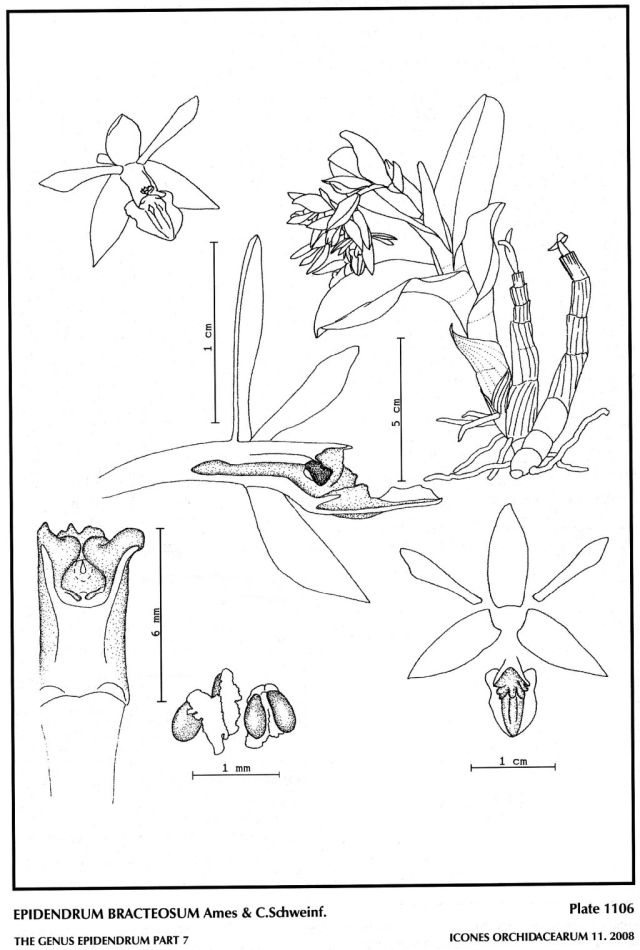

Epidendrum bracteosum Ames & C.Schweinf. 1930 GROUP Bracteosum
TYPE Photo by D Scherberich/TYPE Drawing by Hagsater & Jimenez and The AMO Herbaria Website
Drawing by © Ames and The Epidendra Website


 EARLIER
EARLIER
Common Name The Bracteate Epidendrum [refers to the prominent, conduplicate floral bracts]
Flower Size 1.2" [3 cm]
Found in Costa Rica in oak and elfin forests at the base of trees in mosses at elevations around 3150 meters as a miniature to small sized, cold growing epiphyte with erect, cane-like, short, thick, laterally compressed, straight stems enveloped below by scarious, membraneous bracts carrying 3 to 4, in the apical 1/2 of the stem, coriaceous, elliptic to ovate, rounded and minutely apiculate apically, margin entire, dark green with purple leaves that blooms in the summer through earlier fall on a terminal, racemose, occuring only once, short, thin, ancipitose, straight, arching, 1.4 to 2" [3.5 to 5 cm] long, 3 to 9 flowered inflorescence with a near the base, basally tubular, conduplicate above, narrowly triangular-ovate, subacute, somewhat ancipitose bract with conspicuous, longer than the ovary, conduplicate, cymbiform, acute floral bracts and carrying simultaneously opening, resupinate, non fragrant, pale green slightly tinged with copper flowers.
The small plants with the stems enveloped by scarious sheaths, the wide, rounded apically leaves, the peduncle with 2 bracts, the conduplicate, spaced floral bracts, the green tinged purple flowers with narrowly oblanceolate to spathulate petals and an ovate-cordate lip with 3 very prominent keels characterize this species from others.
"Epidendrum bracteosum belongs to the GROUP Bracteosum which is characterized by the sympodial, caespitose habit with laterally compressed, ancipitose, few-leaved stems covered by tubular, scarious sheaths, a racemose to paniculate, 3 to 11 flowered, arching inflorescence with prominent, acute floral bracts, the floral segments partly spreading, the lip entire, generally auriculate at the base, the disc tricarinate and 4 cuniculate (on each side of the calli), and with fleshy laminar thickenings beneath the calli. The species has 3 to 5 leaves distributed a long the apical half of the stem, the inflorescence racemose to paniculate with the peduncle covered by a single prominent and persistent bract and the floral bracts cymbiform. The species has short plants to 9.2" [23 cm] tall , the sepals .36 to .48" [9 to 12 mm] long, petals spatulate oblanceolate, 1-veined, and the panduriform-cordate lip, .28 to .32" [7 to 8 mm] long. It is very similar to Epidendrum davidsei Hágsater which is larger overall, the plants to 14.8 to 20" [37 to 50 cm] tall, sepals .48 to .6" [12 to 15 mm] long, petals elliptic, 3-veined, and the lip .368 to .48" [9.2 to 12 mm] long. Epidendrum pitalense Salazar, Hágsater & Linares , of the GROUP Bracteosum SUBGROUP Pallens , has 1 to 2 leaved stems, the leaves aggregate towards the apex, the inflorescence longer than the apical leaf, floral bracts tubular, flowers purple-brown, the column green, sepals .56 to .68" [14 to 17 mm] long, and the petals narrowly elliptic." Hagsater etal 2008
Synonyms
References W3 Tropicos, Kew Monocot list , IPNI ; The Genus Epidendrum Ames 1936; Ceiba Vol 5 No 1 L O Williams 1956; Field Guide to the Orchids of Costa Rica and Panama Dressler 1993; Icones Orchidacearum 2 Plate 127 Hagsater & Sanchez 1993 see recognition section; Manual de las Plantas de Costa Rica Vol 3 Hammel, Grayum, Herrera and Zamora 2003; Icones Orchidacearum 11 Plate 1106 Hagsater 2008 Drawing fide; Icones Orchidacearum 11 Plate 1155 Hagsater 2008 see recognition section; Icones Orchidacearum 11 Plate 1161 Hagsater 2008 see recognition section;
--------------------------------------------------------------------------------------------------------------------------